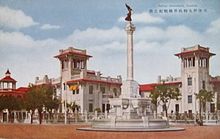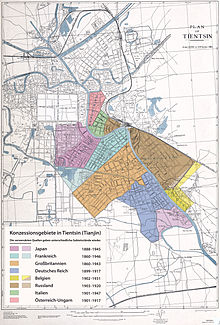Italian concession from Tientsin
The Tientsin Italian Concession was an Italian colonial property in China administered by the Kingdom of Italy from 1901 to 1947 . The concession was the result of the participation of the Italian troops in the suppression of the Boxer Rebellion and was established with the compulsory signing of the Boxer Protocol by the Qing government on September 7, 1901.
The area was 458,000 m² and was one of the smallest Chinese territorial concessions to foreign powers. The area consisted of the immediate eastern suburbs of Tianjin and land on the left bank of the Hai He . The Italian concession lay between the Austro-Hungarian and the Russian concession.
history
Tianjin gained its importance due to its strategic geopolitical location as the port of Beijing, which is about 120 kilometers northwest . After China's defeat in the First Opium War , Great Britain pushed through the opening of Chinese port cities, including Tianjin. The port of Tianjin opened as a treaty port in 1860 as a result of the unequal treaties when concessions for Great Britain, France and the United States were established there.
During the Boxer Rebellion in 1900, the Beijing Legation Quarter was besieged by the Boxers for several months. After the Daily Mail published a fictional report entitled "The Peking Massacre" on July 16, 1900, according to which all whites in the Legation Quarter had been killed, the European governments as well as Japan and the United States decided to initiate a punitive expedition against China. Italy also decided to send a military contingent to China to fight the Boxer Rebellion. Italy thus belonged to the United Eight States , an alliance made up of Italy , the United States, France, Austria-Hungary , Japan , the German Empire , the United Kingdom and Russia .
After the siege by the Eight Nations Alliance was lifted after the Battle of Beijing, the nations of the United Eight States were given the right to station troops to protect their legations in accordance with the provisions of the Boxer Protocol. In addition, Italy received the concession in Tientsin, southeast of Beijing. The concession was administered by a governor who was initially subordinate to the Foreign Ministry and from 1912 to the Colonial Ministry. The concession was officially established in 1902, but the occupation of the area by Italian troops took place as early as January 1901. The Italian Foreign Minister Giulio Prinetti had given permission for this . The first governor from 1901 to 1903 was the diplomat and historian Cesare Poma from Biella . He published the first Italian newspaper to be printed in China, the Bollettino italiano dell'Estremo Oriente .
According to various sources, between 13,700 and 17,000 people lived in the concession in 1902. Most of them were Chinese citizens. In 1935 the population had fallen to about 6,300, including 392 Italians and about 150 foreigners from other nations.
Austria-Hungary was unable to maintain control of its concession, which directly bordered the Italian concession, during World War I and waived all claims on September 10, 1919. Italy then applied for control of the Austro-Hungarian concession, but this was rejected. During the civil war from 1927 to 1928, Italian units occupied the territory of the Austro-Hungarian concession, but withdrew after a short time.
During the Second World War , Italian troops were stationed in the concession. In 1943 the concession had a crew of around 600 Italian soldiers. On September 10, 1943, the concession was occupied by Japan. Mussolini transferred the concession to the reorganized government of the Republic of China set up by Japan , which was not officially recognized by either the Republic of China or the Kingdom of Italy. Only after the war, on February 10, 1947, was it officially ceded by Italy to China.
Architecture in Tientsin
At a conference of the "Orientalist Geographers" in September 1910 in memory of the Jesuit Father Matteo Ricci (1552-1610), one of the most famous missionaries in China and founder of the modern mission to China, Luigi Sborlino gave a speech on "The Italian Concession in Tientsin". In it he sketched a picture of what actually happened over the next few decades:
“In a few months our concession should be comfortably and nicely furnished with numerous European-style houses. We can imagine these two-story houses, some overlooking large boulevards with sidewalks, others surrounded by pretty gardens and small vegetable gardens adorned with verandas, inhabited by our compatriots who are actively involved in industrial and commercial operations both locally and internationally. "
The former concessions in Tientsin were built with typical architecture by the respective nations during the colonial era. Various architectural styles such as castle-like buildings in the German style, Italian squares with fountains, Parisian cafes and French and English gardens are located side by side within a few kilometers. In China, Tianjin is therefore also known as the "permanent exhibition of world architecture".
Former home of Cao Kun
Former home of Liang Qichao (1873–1929) in the Italian concession
Today the Italian villas are mainly used by companies for representational purposes. The urban renewal of the former concession area began around the mid-1990s. Today the Italian concession is also known as Yishi Fengqingqu (roughly: picturesque Italian-style district ).
List of Governors of the Tientsin Concession
- Cesare Poma (1901-1904)
- Giuseppe Chiostri (1904–1906)
- Oreste Da Vella (1906–1911)
- Vincenzo Fileti (1912-1920)
- Marcello Roddolo (1920-1921)
- Luigi Gabrielli di Quercita (1921-1924)
- Guido Segre (1925-1927)
- Luigi Neyrone (1927-1932)
- Filippo Zappi (1932-1938)
- Ferruccio Stefenelli (1938–1943)
literature
- Shirley Ann Smith: Imperial Designs: Italians in China 1900–1947. Fairleigh Dickinson University Press, Madison 2012, ISBN 978-1-611-47501-2 .
- Sandro Bassetti: Colonia italiana in Cina. Tipubblica, 2014, ISBN 978-8-848-81656-4 .
Individual evidence
- ^ A b Maurizio Marinelli: Finding the imagined motherland in China: the Italian experience in Tianjin. In: Provincial China. 3.1, 2011, pp. 80-110.
- ^ Maurizio Marinelli: Making concessions in Tianjin: heterotopia and Italian colonialism in mainland China. In: Urban History. 36, 2009, doi: 10.1017 / S0963926809990150 , pp. 399-425.
- ↑ Geoffrey Pen: The Fists of Righteous Harmony: A History of the Boxer Uprising in China in the Year 1900. Pen & Sword Books Ltd., 1991, ISBN 978-0850524031 , pp. 144-145.
- ^ Valter Astolfi: Soldati italiani in Cina 1866/1946. In: Aicpm.net. Retrieved September 14, 2019.
- ↑ Maurizio Marinelli, G. Andornino: Italy's Encounters with Modern China: Imperial Dreams, Strategic Ambitions. Palgrave Macmillan, 2014, ISBN 978-1137290922 .
- ^ Davide Mana: Cesare Poma: il primo console italiano in Cina. In: Rivistasavej.it. Retrieved September 14, 2019.
- ↑ a b Maurizio Marinelli: Self-portrait in a convex mirror: colonial Italy reflects on Tianjin. In: Transtext (e) s Transcultures 跨 文本 跨 文化. Journal of Global Cultural Studies. 2007, doi: 10.4000 / transtexts.147 , pp. 119–150.
- ^ A b Maurizio Marinelli: The Triumph of the Uncanny: Italians and Italian Architecture in Tianjin. In: Cultural Studies Review. 19, 2013, doi : 10.5130 / csr.v19i2.2846 , pp. 70-98.
- ^ Maurizio Marinelli: Projecting Italianità on the Chinese Space: The Construction of the “Aristocratic” Concession in Tianjin (1901–1947) . In: Maurizio Marinelli, G. Andornino: Italy's Encounters with Modern China: Imperial Dreams, Strategic Ambitions. Palgrave Macmillan, New York, 2014, ISBN 978-1-349-45064-0 , pp. 1-25.
Coordinates: 39 ° 8 ′ 6 ″ N , 117 ° 11 ′ 38 ″ E









